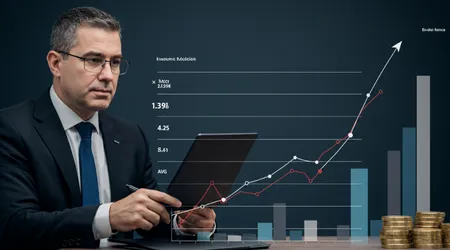UK Economy 2025: Key Indicators to Watch This Quarter

The UK Economy 2025 stands at a crossroads, shaped by global uncertainties and domestic policy shifts. As we dive into this quarter, understanding the forces driving growth, inflation, and employment becomes crucial for businesses, policymakers, and citizens alike.
From trade disruptions to consumer confidence, the economic landscape is dynamic, demanding sharp attention to key indicators.
This article unpacks the metrics that will define the UK Economy 2025, offering actionable insights for navigating the months ahead.
Why should you care about these trends? Because they’ll shape everything from your grocery bill to your job prospects.
Recent data paints a complex picture. The Office for National Statistics (ONS) reported that UK GDP grew by just 0.5% in Q1 2025, signaling fragile recovery amid global trade tensions and domestic fiscal adjustments.
This sets the stage for a deeper exploration of the indicators that will steer the UK Economy 2025 through turbulent waters. Let’s break it down with clarity and precision, avoiding the noise and focusing on what matters most.
GDP Growth: A Fragile Recovery
Economic output is the heartbeat of the UK Economy 2025, and GDP growth remains a critical gauge. The ONS recorded a modest 0.5% increase in Q1 2025, down from earlier projections of 1.0%. This slowdown reflects cautious business investment and weaker export performance.
For instance, a small manufacturing firm in Birmingham might hesitate to expand due to rising costs and uncertain demand.
Trade disruptions, particularly potential U.S. tariffs under President-elect Trump, could further dampen growth.
The National Institute of Economic and Social Research (NIESR) warns that tariffs may shave 0.2% off GDP by year-end. Businesses must monitor quarterly GDP updates to adjust strategies, especially in export-driven sectors like automotive.
Moreover, consumer spending, a key GDP driver, is under pressure. With real incomes recovering slowly, households are prioritizing essentials over discretionary purchases.
Retailers, like a London-based clothing chain, may see flat sales unless confidence rebounds. Tracking GDP trends offers a window into whether stimulus measures, like front-loaded government spending, will ignite growth.

Inflation: Balancing Act for the Bank of England
Price pressures are a persistent concern for the UK Economy 2025. CPI inflation hit 3.6% in June 2025, up from 3.4% in May, per the ONS.
This uptick, driven by core goods and services, challenges the Bank of England’s 2% target. Rising energy costs, tied to European gas price spikes, add complexity.
The Bank’s Monetary Policy Committee held interest rates at 4.25% in June, but Governor Andrew Bailey hinted at four potential cuts in 2025 if inflation cools.
Also read: Nearly One in Five NHS Doctors Considering Going Abroad Amid Pay and Training Frustrations
For example, a family in Manchester might benefit from lower mortgage rates if cuts materialize. However, geopolitical risks, like Middle East tensions, could keep oil prices volatile, pushing inflation higher.
Retail businesses face a squeeze as input costs rise. A café in Bristol, for instance, may pass on higher coffee bean prices to customers, risking sales.
Monitoring inflation trends is vital for anticipating rate decisions and managing household budgets in the UK Economy 2025.
Inflation’s ripple effects touch wages too. Real wage growth, adjusted for inflation, was 1.8% in Q1 2025, supporting consumer spending but not enough to offset rising costs entirely.
Businesses must balance wage increases with profitability, making inflation a key indicator to watch closely.
Employment and the Labour Market: A Tightrope Walk
Jobs data is a cornerstone of the UK Economy 2025, reflecting both opportunity and strain. The ONS reported 34.13 million people employed in Q1 2025, up 754,000 from last year.
Yet, the unemployment rate rose to 4.7%, signaling a loosening market. A tech startup in Cambridge, for example, may struggle to hire skilled workers amid rising costs.
The Autumn Budget’s increase in employers’ National Insurance Contributions (NICs) threatens job creation. NIESR predicts unemployment could peak at 4.9% by year-end.
Small businesses, like a Leeds bakery, might cut hours to offset higher payroll taxes, impacting local economies.
Read more: Ofgem Launches Plan to Make Energy Bills Progressive—Wealthy Households Could Pay More
Wage growth, at 5.0% excluding bonuses, offers some relief. However, a loosening labour market could temper this. Firms must track employment trends to navigate hiring challenges, while workers watch for job security in a shifting UK Economy 2025.
The labour market’s resilience hinges on consumer confidence. GfK’s Consumer Confidence Index fell to -19 in July 2025, reflecting uncertainty.
If confidence doesn’t recover, reduced spending could further weaken job growth, creating a feedback loop businesses must anticipate.
Trade and Exports: Navigating Global Headwinds
Trade performance is a linchpin for the UK Economy 2025, but challenges loom. The ONS reported a £17.1 billion trade deficit in Q1 2025, up from £10.7 billion in Q4 2024. Potential U.S. tariffs, as flagged by NIESR, could hit UK exporters hard, especially in manufacturing.
Services, a UK strength, offer some buffer. For instance, a London-based fintech firm may thrive despite goods trade woes, as U.S. demand for digital services grows.
Still, global uncertainties, like China’s economic slowdown, could curb export opportunities, requiring firms to diversify markets.
Sterling’s value, up 2.9% year-on-year, impacts competitiveness. A stronger pound makes UK goods pricier abroad, challenging exporters like a Sheffield steelmaker.
Monitoring trade balances and currency trends is essential for businesses eyeing international markets in the UK Economy 2025.
Government trade deals, like those easing manufacturing exports, could provide relief. However, firms must stay agile, as geopolitical shifts, such as U.S. policy changes, could disrupt supply chains. Tracking trade data will guide strategic pivots.
Consumer Confidence and Spending: The Pulse of Recovery
Consumer sentiment drives the UK Economy 2025, influencing spending and growth. GfK’s Consumer Confidence Index at -19 in July 2025 signals caution.
Households, wary of tax hikes and inflation, are tightening budgets, impacting retailers like a Cardiff electronics store.
Retail sales grew just 0.2% in Q2 2025, per the ONS, reflecting subdued demand. For example, a family in Glasgow might skip a new TV purchase, prioritizing bills. Government spending measures may boost demand, but only if confidence improves.
Businesses must adapt to cautious consumers. Offering discounts or flexible payment plans, like a furniture retailer in Birmingham, could sustain sales. Tracking consumer confidence data helps predict spending patterns critical to the UK Economy 2025.
Digital platforms, like TikTok or Instagram, are shaping spending habits, especially among younger consumers.
Brands leveraging these channels for targeted campaigns may offset weaker high-street sales, making consumer trends a key focus.
Public Finances and Fiscal Policy: The Government’s Role

Fiscal policy shapes the UK Economy 2025, with public finances under scrutiny. Government borrowing reached £57.8 billion in Q1 2025/26, up £7.5 billion from last year, per the ONS. Tight fiscal headroom limits bold investments, as KPMG notes.
The Autumn Budget’s tax hikes, including NICs, aim to fund growth but risk stifling it. A small business in Liverpool, for instance, may cut expansion plans due to higher taxes. Public debt at 96.3% of GDP signals long-term challenges.
Investment in infrastructure, like rail upgrades in the North, could stimulate growth. However, businesses must monitor fiscal announcements, as policy shifts could alter tax burdens or funding opportunities in the UK Economy 2025.
The Chancellor’s focus on investment-led growth offers hope, but risks like global trade tensions could derail plans. Staying informed on fiscal updates ensures businesses and households can plan effectively.
Table: Key Economic Indicators for Q3 2025
| Indicator | Value | Source |
|---|---|---|
| GDP Growth (Q1 2025) | 0.5% | ONS |
| CPI Inflation (June 2025) | 3.6% | ONS |
| Unemployment Rate | 4.7% | ONS |
| Trade Deficit (Q1 2025) | £17.1 billion | ONS |
| Consumer Confidence | -19 (July 2025) | GfK |
| Public Debt (% of GDP) | 96.3% | ONS |
Practical Strategies for Businesses and Households
Navigating the UK Economy 2025 requires proactive steps. Businesses should leverage data analytics to track consumer trends, like a Manchester retailer using sales data to optimize inventory. Diversifying export markets, such as targeting Asia, can mitigate trade risks.
Households can manage budgets by prioritizing high-yield savings accounts, as interest rates may fall.
For example, a teacher in Bristol could switch to a fixed-rate mortgage to lock in lower payments. Staying informed via trusted sources like the ONS is key.
Digital marketing, optimized for platforms like YouTube, can boost visibility. A travel agency in Leeds, for instance, might use video SEO to attract clients. Adapting to economic signals ensures resilience in the UK Economy 2025.
Analogous to a ship navigating stormy seas, the UK Economy 2025 demands steady hands and sharp eyes. Businesses and households must adjust sails to weather global and domestic challenges, using data as their compass.
Conclusion: Steering Through Uncertainty
The UK Economy 2025 is a complex tapestry of opportunity and risk. GDP growth, inflation, employment, trade, consumer confidence, and fiscal policy are the threads to watch.
Each indicator, from the ONS’s 0.5% GDP growth to GfK’s -19 confidence score, tells a story of cautious recovery.
Businesses, like a Southampton café tweaking prices, and households, like a family in Edinburgh cutting discretionary spending, must adapt to thrive.
By monitoring these metrics, stakeholders can make informed decisions. Whether you’re a business
owner eyeing exports or a worker planning finances, understanding the UK Economy 2025 is your edge. Stay vigilant, stay strategic, and let data guide your path through this quarter’s challenges.
Frequently Asked Questions
What’s driving inflation in the UK in 2025?
Rising energy costs and core goods prices, per the ONS, with geopolitical risks adding pressure. Monitor Bank of England rate decisions closely.
How can businesses prepare for trade disruptions?
Diversify markets, like targeting Asia, and optimize digital presence, as a Leeds firm did with YouTube campaigns, to offset export challenges.
